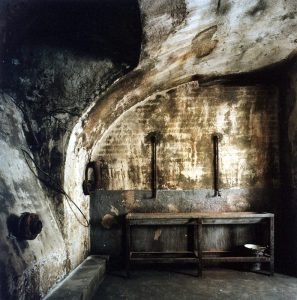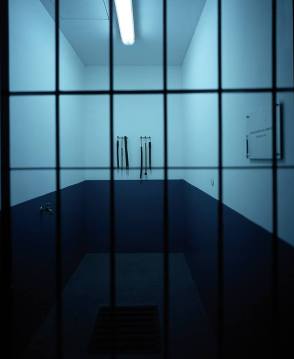Following a recent trip to Budapest, Hungary, IRCT Communications Officer Ashley Scrace recounts his visit to the House of Terror – a part-museum, part-memorial recounting the torture in the city.

The torture chamber at the House of Terror (picture courtesy of Rajmund Fekete, House of Terror museum)
To tourists and locals, Andrássy út in Budapest is renowned as one of the grandest roads through the sprawling eastern Pest side of the city. But Budapest’s beautiful boulevard has a dark past, one punctuated by torture, terror, and death.
Based in the former headquarters for the secret police of both the Nazi and Communist governments, the House of Terror at number 60 Andrássy út is a museum-memorial reflecting on the terrifying decades of Nazi and Communist repression across Hungary.
Much of the museum features exhibits relating to the torture during the regimes, with particular focus on the extermination of the Jewish population across Budapest by the Nazis and the Communists.
Towards the end of World War II, Budapest was overpowered by the Nazi-affiliated Arrow Cross Movement – a movement which did its best to continue the will of the Nazis and exterminate all of Budapest’s Jewish population. From one-by-one shootings in the streets, to hangings and group executions into the freezing River Danube, they executed hundreds of Jews from across the city.
Another place for executions, extensive torture, and interrogation, was the basement of 60 Andrássy út, where the House of Terror stands today. When the communists moved into Hungary in the late-1940s’, they took over the same building used by the Arrow Cross movement as the headquarters of their secret police (the ÁVO, later renamed ÁVH).
By the time the transition to Stalinist rule was complete in 1949, the headquarters were already feared and known as a place of torture used to silence not only the Jewish population, but to silence any civilians whose views differed to those of the state.
It was in the basement where, until the Hungarian Revolution of 1956, ‘enemies of the state’ were tortured an imprisoned. In order to remember this today, the museum carefully recreates the torture chambers and prison cells used by the secret police, complete with some original torture devices.
It’s an eerie experience to walk around these chambers, knowing you are treading on a past hub of torture. The prisoners in these cells had no hope, and while not all of them were killed under interrogation, the torture ruined their lives and the lives of their families for years to come.
The historical context of both the Nazi and Communist regimes are summarised across a series of information boards, pictures and video clips which becoming increasingly chilling as the journey through the museum unravels. And the entrance hall, which features pictures of all victims of torture in the building, haunts you as you enter and exit the museum.
It is harrowing to think that some of the elderly locals who visit the museum perhaps have personal ties to some of the victims, and perpetrators, listed in the museum. The dark history of Hungary is, after all, not that far in the past.
Thankfully the life of 60 Andrássy út transformed following the 1956 revolution – it became a local Communist youth club. But the traumatic, horrifying atmosphere of the building remains, even with renovation. The walls of the building do contain stories, stories which are perhaps too dark or distressing to ever fully be told.
But the House of Terror does a good job of telling these stories. While criticisms exist regarding the narrow focus of the exhibits – which specifically omit some Hungarian sympathies which existed at the time towards the extermination of the Jews – the museum overall paints an insightful, disturbing picture of the past, reminding visitors just how incapacitating torture is and why it is torture, not communities, which should be eradicated.
